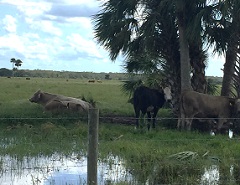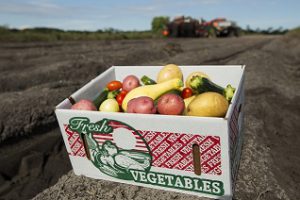How Hurricanes Affect Agriculture and Higher Grocery Prices – thank a farmer every time you eat!
Many of our agriculture producers along the Treasure Coast did not fare so well with hurricane Irma and the additional week of steady rains right after. Pastures, needed for beef cattle production and horse enthusiasts, were under water for weeks. Flooded root systems begin to die off within a few days due to lack of oxygen and stressed pastures are more susceptible to pests and diseases, just at a time when they need to be preparing for winter dormancy.
 Citrus, already devastated in previous years by a variety of diseases (greening being the worse so far) saw 30-50% of their crop on the ground immediately after the storm passed. Most, if not all, of this fruit is unsalvageable due to fruit damage and food safety concerns and restrictions. Other fruits and vegetables were equally affected; vegetable crops that were already in the ground, like corn, lettuce, spinach, tomatoes and many others, were killed during the high winds, rain and flooding. Plant beds covered in plastic mulch were destroyed and have to be rebuilt and the plastic replaced. Greenhouses were tossed around like toys, completely demolishing them.
Citrus, already devastated in previous years by a variety of diseases (greening being the worse so far) saw 30-50% of their crop on the ground immediately after the storm passed. Most, if not all, of this fruit is unsalvageable due to fruit damage and food safety concerns and restrictions. Other fruits and vegetables were equally affected; vegetable crops that were already in the ground, like corn, lettuce, spinach, tomatoes and many others, were killed during the high winds, rain and flooding. Plant beds covered in plastic mulch were destroyed and have to be rebuilt and the plastic replaced. Greenhouses were tossed around like toys, completely demolishing them.
All of this will lead to additional costs for the farmer that were not expected and losses are estimated in the billions. Farmers are a hearty and brave lot though, and many are confident that they will be back in business before too long. Most of the local farmers that I talked to were already back in the fields cleaning up, pumping water out of the fields and planning to replant. I am always impressed by their dedication and resiliency—their willingness to keep going, no matter what, to feed our country.

 Unfortunately, hurricanes that affect agricultural areas are costly for the consumer as well—reflected in higher prices at the grocery store. You may have noticed that it took a few weeks for most supermarkets to become well stocked again and that your grocery bill might already be a slightly higher. This could increase as much as 10-15% over the next couple of months due to crop losses and the increase cost of replanting, labor and transportation. Experts predict that this hike will only be seen through Thanksgiving and that grocery prices should normalize after a few months as produce is readily available again and the supply chain fully recovers. For families on limited incomes, fluctuating food prices are hard to prepare for, and fresh fruits and vegetables are usually replaced with cheaper, and often less nutritious, alternatives. The good news is that once agriculture recovers, so should food prices and we should see normal, or near normal, prices return with just a 1% overall increase for 2017. Good news for most of us, since we usually eat at least three times a day! If you ever have the chance, do not forget to thank those farmers for going back to work and putting food on our tables.
Unfortunately, hurricanes that affect agricultural areas are costly for the consumer as well—reflected in higher prices at the grocery store. You may have noticed that it took a few weeks for most supermarkets to become well stocked again and that your grocery bill might already be a slightly higher. This could increase as much as 10-15% over the next couple of months due to crop losses and the increase cost of replanting, labor and transportation. Experts predict that this hike will only be seen through Thanksgiving and that grocery prices should normalize after a few months as produce is readily available again and the supply chain fully recovers. For families on limited incomes, fluctuating food prices are hard to prepare for, and fresh fruits and vegetables are usually replaced with cheaper, and often less nutritious, alternatives. The good news is that once agriculture recovers, so should food prices and we should see normal, or near normal, prices return with just a 1% overall increase for 2017. Good news for most of us, since we usually eat at least three times a day! If you ever have the chance, do not forget to thank those farmers for going back to work and putting food on our tables.

 0
0
